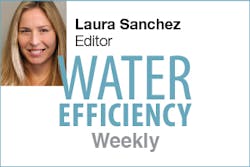This spring, more than 100 affiliate organizations from all sectors of the nation’s economy and civil society are working together to create discussion about infrastructural renewal. These efforts support Infrastructure Week (May 16–May 23), a national advocacy and education campaign aimed at elevating infrastructure as a critical issue in America. Forester Media, the publisher of Water Efficiency, is an Infrastructure Week affiliate. We’re pleased to help lead the conversation.
This year’s theme—“Infrastructure Matters”—asks Americans to consider what infrastructure means to each of us. Many have discovered that it matters, in big ways and in small, to our economy, our quality of life, our safety, and our communities—from roads and bridges to rails, ports, pipes, the power grid, and broadband. Infrastructure is the foundation for every aspect of our daily lives. And that foundation is in need of repair.
To initiate discussion we recently reached out to industry experts with four questions regarding the state of our infrastructure. Here Melissa Meeker offers her insight.
Meeker is the executive director of the Water Environment Research Foundation and the WaterReuse Association. She is a seasoned water executive with more than 20 years of experience in both the public and private sectors, with a broad range of expertise that includes regulatory issues, policy development, and executive management. She has served as executive director of the South Florida Water Management District and as deputy secretary of the Florida Department of Environmental Protection, with responsibility for overseeing statewide water and environmental restoration policy.
Water Efficiency (WE): Which infrastructure projects should be given priority? Roads and bridges? Dams and levees? Water supply? Electrical grid?
Melissa Meeker (MM): All of these areas are important and we cannot look at them in isolation. Our organization and others are pushing for a shift toward resilient systems in which we take a holistic, systems view of water as well as other infrastructure such as transportation and energy. The nation’s infrastructure is completely interdependent. We cannot produce electricity or build bridges without water, and we cannot treat and move water without energy and roads.
It is clear that the nation’s infrastructure needs immediate attention. In water, for example, EPA has reported that our wastewater systems face $271 billion in documented needs over the next twenty years—investments in publicly owned wastewater conveyance and treatment facilities, combined sewer overflow correction, and stormwater management. Drinking water systems require $384 billion in documented infrastructure rehabilitation and improvements over the same timeframe according to EPA, and over $1 trillion according to the American Water Works Association.
WE: Is there a solution to long-term infrastructure funding?
MM: This is where it is particularly important to take a holistic, systems view of the nation’s infrastructure. Funding is key to fixing and improving existing infrastructure, but we also need to look at creating sustainable interconnected systems to make the dollars go further and the systems more resilient. An organized federal commitment is essential, along with federal/state and also public/private partnerships.
While many state and federal financing programs already help support infrastructure projects, unfortunately these programs are often underfunded and subjected to the whims of the contemporary political climate. Frequent, unpredictable variations in appropriation levels, constantly changing rules, and uncertain regulations make it hard for project managers and investors to plan and execute multi-year, multi-phase projects. We will only solve long-term infrastructure funding issues when our leaders prioritize a real, long-term commitment to repairing and strengthening the infrastructure backbone that enables ordinary Americans each and every day to take a safe shower, drink a glass of clean water, and drive to work on roads and bridges that aren’t in danger of collapsing along the way.
WE: What kind of harm is the current state of our infrastructure doing to the economy and the community?
MM: Throughout history, we have seen that investment in infrastructure can have a dramatic impact on economic development. Likewise, a business’s ability to expand and grow can be severely limited by a lack of infrastructure. A business in the western United States, for example, might not be able to take advantage of expansion opportunities if there is not a reliable water supply to support the business. Infrastructure that allows wastewater to be treated and used for beneficial purposes would provide the water that the business needs to expand in this scenario. Reliable infrastructure of all kinds is needed to create an environment of economic growth. Infrastructure investment also stimulates the economy through job creation.
Infrastructure deficiencies do not just affect businesses; they impact our quality of life. Communities across the nation, large and small, exist because of infrastructure. Crumbling roads and bridges are not pleasant to drive on and can be unsafe. Energy is an essential part of our daily lives. And without a reliable and safe water supply, a community will simply cease to exist.
WE: What can various government entities—from local to federal—do to attract private sector support and investment?
MM: There are wonderful examples out there that others can follow. In southern California, the West Basin Municipal Water District has partnered with an oil refinery to build infrastructure to treat and deliver specially treated recycled water to the refinery. In 2013, Florida passed a law that allows private companies to submit unsolicited proposals to local governments.
Uncertainty is one of the biggest deterrents against investment. Private investors hesitate when considering a project that includes government supported financing because who knows whether that program will expire or be zeroed out the following year. The quality and strength of our infrastructure are too important to play politics with.
WE: Thank you, Melissa.
We invite you to share your perspective here as well.

